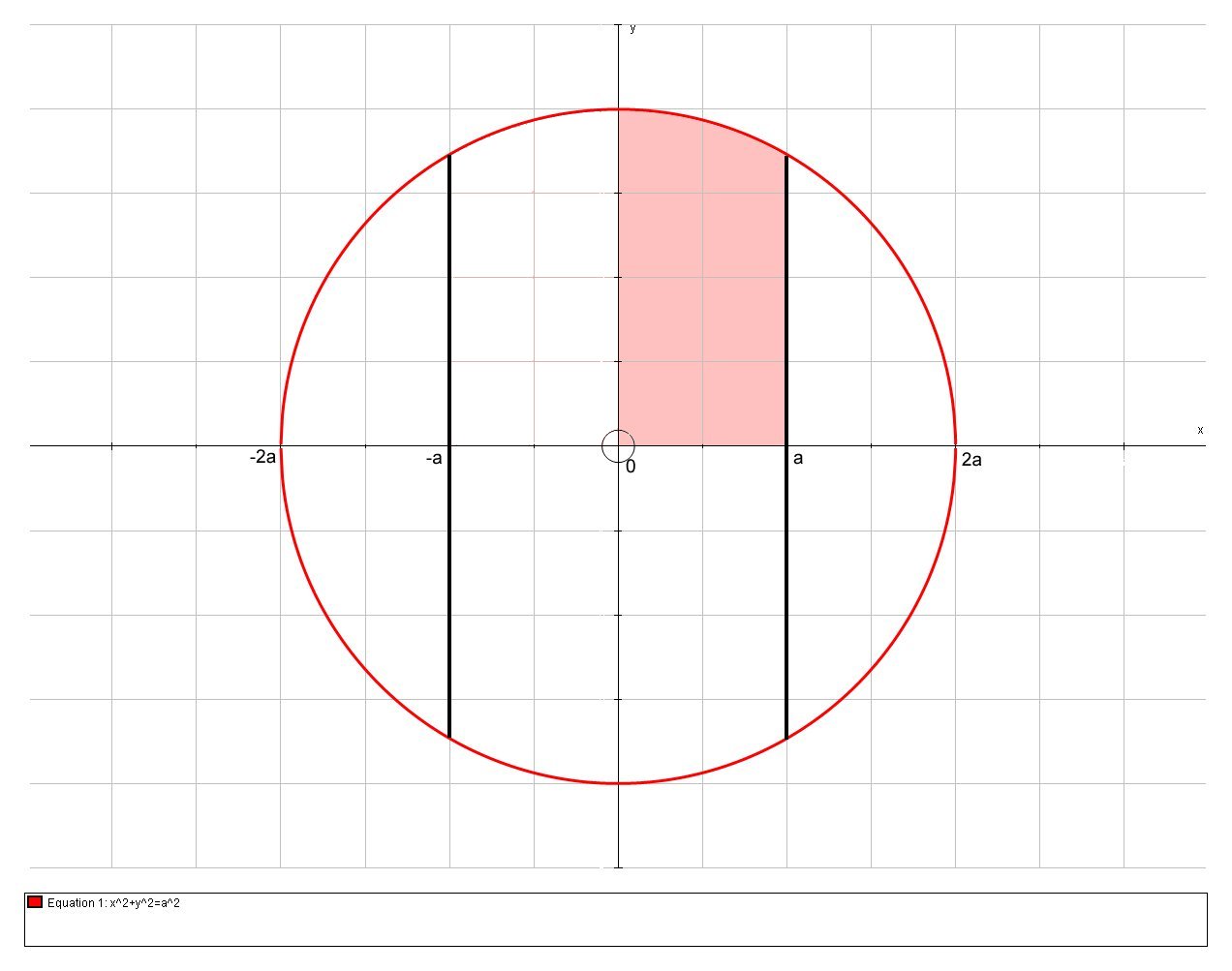A Sphere of radius #2a# has a hole of radius #a# drilled through the centre. What is the remaining volume?
2 Answers
Explanation:
Consider the section of the solid with a plane containing the axis of the cylinder and establish a system of reference with origin in the center of the sphere and with the axis of the cylinder as
The volume of the remaining solid is generated by the rotation around this axis of the area delimited by the semi circle or radius
For reasons of symmetry this is twice the volume of the area of the first quadrant comprised between the quarter circle of radius
The two curves intercept when:
The volume generated by the rotation of the area between
and integrating over the interval
We can also calculate this geometrically, since the volume of the remaining solid is the volume of the sphere
Now:
The height of the spherical caps is given by the formula:
and their volume is:
The heigth of the cylinder is the diameter of the sphere minus the height of the caps:
so its volume is:
and finally:
# 4sqrt(3)pia^3 #
Explanation:
We basically are being asked to calculate the volume of a spherical bead, that is, a sphere with a hole drilled through it.
Consider a cross section through the sphere, which we have centred on the origin of a Cartesian coordinate system:

The red circle has radius
# x^2+y^2=(2a)^2 => x^2+y^2=4a^2#
Method 1 - Calculate core and subtract from Sphere
First let us consider the volume of the entire Sphere, which has radius
# :. V_("sphere") = 4/3 pi (2a)^3 #
# " " = 4/3 pi 8a^3 #
# " " = 32/3 pi a^3 #
For the bore we can consider a solid of revolution. (Note this is not a cylinder as it has a curved top and bottom from the sphere). We will use the method of cylindrical shells and rotate about
# V = 2pi \ int_(alpha)^(beta) \ xf(x) \ dx #
Also note that we require twice the volume because we have a portion above and below the
# V_("bore") = 2pi \ int_(0)^(a) \ x(2sqrt(4a^2-x^2)) \ dx #
# " " = 2pi \ int_(0)^(a) \ 2x \ sqrt(4a^2-x^2) \ dx #
We can evaluate using a substitution:
Let
#u=4a^2-x^2 => (du)/dx = -2x#
When# { (x=0), (x=a) :} => { (u=4a^2), (u=3a^2) :}#
And so:
# V_("bore") = -2pi \ int_(4a^2)^(3a^2) \sqrt(u) \ du #
# " " = 2pi \ int_(3a^2)^(4a^2) \sqrt(u) \ du #
# " " = 2pi \ [ u^(3/2)/(3/2) ] _(3a^2)^(4a^2) #
# " " = (4pi)/3 \ [ u^(3/2) ] _(3a^2)^(4a^2) #
# " " = (4pi)/3 \ ((4a^2)^(3/2) - (3a^2)^(3/2)) #
# " " = 4/3pi \ (8a^3-3sqrt(3)a^3) #
# " " = 32/3pi a^3-4sqrt(3)pia^3 #
And so the total volume is given by:
# V_("total") = V_("sphere") - V_("bore" #
# " " = 32/3 pi a^3 - (32/3pi a^3-4sqrt(3)pia^3)#
# " " = 4sqrt(3)pia^3#
Method 2 - Calculate volume of bead directly
We can use the same method of a solid of revolution using the method of cylindrical shells and rotate about
# V_("total") = 2pi \ int_(a)^(2a) \ x(2sqrt(4a^2-x^2)) \ dx #
# " " = 2pi \ int_(a)^(2a) \ 2x \ sqrt(4a^2-x^2) \ dx #
We can evaluate using a substitution:
Let
#u=4a^2-x^2 => (du)/dx = -2x#
When# { (x=a), (x=2a) :} => { (u=3a^2), (u=0) :}#
And so:
# V_("total") = -2pi \ int_(3a^2)^(0) \sqrt(u) \ du #
# " " = 2pi \ int_(0)^(3a^2) \sqrt(u) \ du #
# " " = 2pi \ [ u^(3/2)/(3/2) ] _(0)^(3a^2) #
# " " = (4pi)/3 \ [ u^(3/2) ] _(0)^(3a^2) #
# " " = (4pi)/3 \ ((3a^2)^(3/2) - 0) #
# " " = (4pi)/3 \ (3sqrt(3)a^3 )#
# " " = 4sqrt(3)pia^3 # , as above


